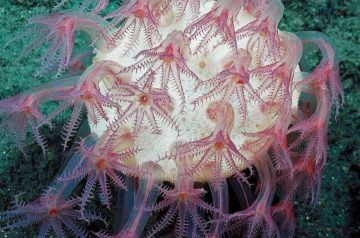Veronique Greenwood in Harvard Magazine:
 IN A CAVERNOUS underground space behind Harvard’s Biological Laboratories, biochemist Peter Girguis frowns at the pressure vessel in his hand. The machined titanium cylinder, about the size of a French press, gleams as he works to release the cap, and he chuckles at his own stubbornness. He could probably find a tool to loosen it, he remarks. But Girguis has a calm self-assurance around physical objects more characteristic of aircraft mechanics in overalls than biochemists. With a flick of his wrist, the cap is out. The walls of the vessel turn out to be nearly an inch thick, the space inside about the size of a jam jar. This summer it will become home to a species of deep-sea snail scooped up by a remotely operated vehicle three miles down, where the pressure is about 3,200 pounds per square inch. The pressure on the surface is a mere 15 pounds per square inch—comfortable for humans, but inhospitable to creatures from the deeps—so on their research ship, Girguis and his colleagues have about 45 minutes to re-create the deep-sea pressure in the vessel and fill it with hydrogen sulfide, oxygen, and other essentials before the snail starts to die. Once they stabilize the conditions in the vessel, they have a compact, nearly intact fragment of an ecosystem so far removed from our own that, for a long time, there were few ways to study it directly.
IN A CAVERNOUS underground space behind Harvard’s Biological Laboratories, biochemist Peter Girguis frowns at the pressure vessel in his hand. The machined titanium cylinder, about the size of a French press, gleams as he works to release the cap, and he chuckles at his own stubbornness. He could probably find a tool to loosen it, he remarks. But Girguis has a calm self-assurance around physical objects more characteristic of aircraft mechanics in overalls than biochemists. With a flick of his wrist, the cap is out. The walls of the vessel turn out to be nearly an inch thick, the space inside about the size of a jam jar. This summer it will become home to a species of deep-sea snail scooped up by a remotely operated vehicle three miles down, where the pressure is about 3,200 pounds per square inch. The pressure on the surface is a mere 15 pounds per square inch—comfortable for humans, but inhospitable to creatures from the deeps—so on their research ship, Girguis and his colleagues have about 45 minutes to re-create the deep-sea pressure in the vessel and fill it with hydrogen sulfide, oxygen, and other essentials before the snail starts to die. Once they stabilize the conditions in the vessel, they have a compact, nearly intact fragment of an ecosystem so far removed from our own that, for a long time, there were few ways to study it directly.
More here.
